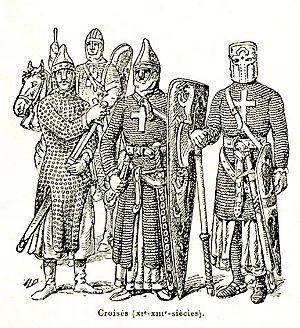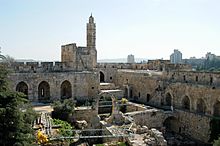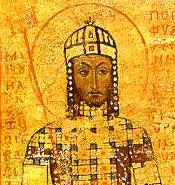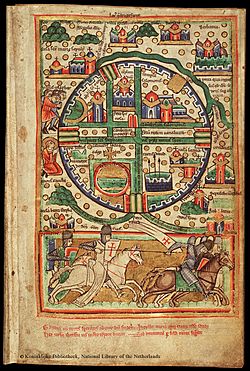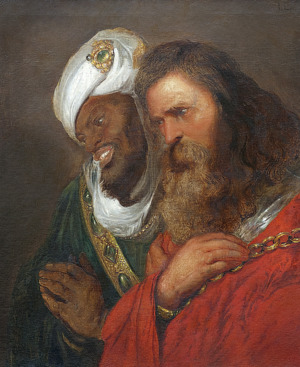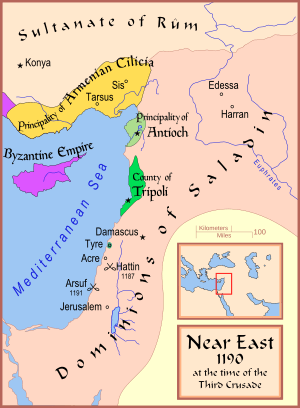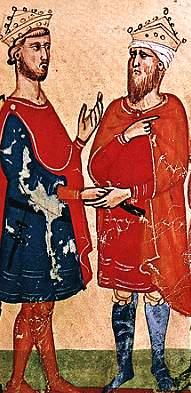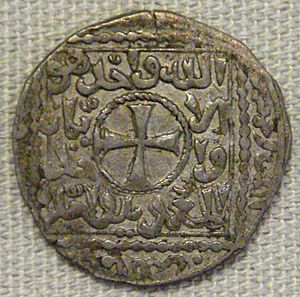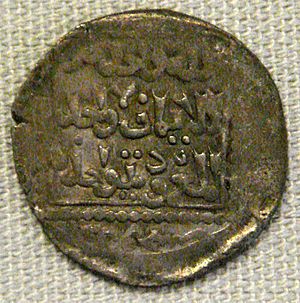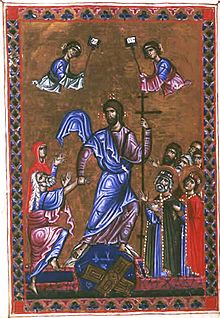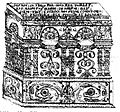Kingdom of Jerusalem facts for kids
Quick facts for kids
(Latin) Kingdom of Jerusalem
|
|||||||||||||||
|---|---|---|---|---|---|---|---|---|---|---|---|---|---|---|---|
| 1099–1187 1192–1291 |
|||||||||||||||
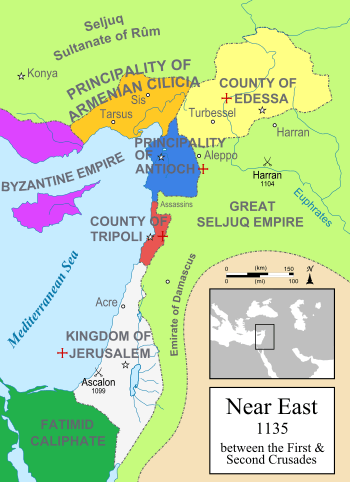
The Kingdom of Jerusalem and the other Crusader states in the context of the Near East in 1135.
|
|||||||||||||||
| Capital | |||||||||||||||
| Common languages |
|
||||||||||||||
| Religion |
|
||||||||||||||
| Government | Feudal monarchy | ||||||||||||||
| King of Jerusalem | |||||||||||||||
|
• 1100–1118 (first)
|
Baldwin I | ||||||||||||||
|
• 1285–1291 (last)
|
Henry II | ||||||||||||||
| Legislature | Haute Cour | ||||||||||||||
| Historical era | High Middle Ages | ||||||||||||||
| 1095–1099 | |||||||||||||||
| 15 July 1099 | |||||||||||||||
| 2 October 1187 | |||||||||||||||
| 1189–1192 | |||||||||||||||
| 1228–1229 | |||||||||||||||
| 1239–1241 | |||||||||||||||
|
• 2nd Fall of Jerusalem
|
15 July 1244 | ||||||||||||||
| 18 May 1291 | |||||||||||||||
| Population | |||||||||||||||
|
• 1131
|
250,000 | ||||||||||||||
|
• 1180
|
480,000–650,000 | ||||||||||||||
| Currency | Bezant | ||||||||||||||
|
|||||||||||||||
The Kingdom of Jerusalem was a special state created by European crusaders in the Southern Levant (the area that includes modern-day Israel, Palestine, and parts of Lebanon and Jordan). It was founded in 1099 by Godfrey of Bouillon after the First Crusade. This kingdom lasted for almost 200 years, until 1291, when its last city, Acre, was destroyed by the Mamluks.
The kingdom's history is often split into two main parts. The First Kingdom of Jerusalem existed from 1099 to 1187. During this time, it was mostly taken over by the famous Muslim leader Saladin. After the Third Crusade, the kingdom was re-established in Acre in 1192. This second period, sometimes called the Second Kingdom of Jerusalem or the Kingdom of Acre, lasted until 1291. Acre became the new capital, except for a short time when Frederick II managed to get Jerusalem back through talks, not fighting.
Most of the crusaders who came to live in the Kingdom of Jerusalem were from France. They were the knights and soldiers who kept the kingdom going for two centuries. Because of this, the rulers and important people were mostly of French background. They also brought the French language with them, which became the main language used in the Crusader states.
The majority of people living in the countryside were local Muslims and Christians. However, many Europeans, mainly French and Italian, also settled in the villages. An important industry that grew here was sugar refining, which used local sugarcane plants.
Contents
- Where the Kingdom Was Located
- People of the Kingdom
- History of the Kingdom
- First Crusade and Kingdom's Start
- Kingdom's Expansion
- Edessa, Damascus, and the Second Crusade
- Internal Conflicts and Byzantine Alliance
- Struggle for Power and Saladin's Rise
- Loss of Jerusalem and the Third Crusade
- The Kingdom of Acre
- Fifth and Sixth Crusades and Frederick II
- Internal Conflicts and the Barons' Crusade
- Louis IX's Crusade and the Mamluks
- Mongol Invasions
- Fall of Acre
- Life in the Early Kingdom
- Legacy of the Kingdom
- Images for kids
- See also
Where the Kingdom Was Located
At first, the Kingdom of Jerusalem was just a few towns and cities captured during the First Crusade. But at its biggest in the mid-1100s, it covered much of what is now Israel, Palestine, and southern Lebanon.
It stretched from Beirut in the north to the Sinai Desert in the south, along the Mediterranean Sea. To the east, it reached into modern Jordan and Syria, and to the west, it bordered Fatimid Egypt.
Three other Crusader states were located further north: the County of Edessa (1097–1144), the Principality of Antioch (1098–1268), and the County of Tripoli (1109–1289). These states were independent but worked closely with Jerusalem. Beyond them were the Armenian Kingdom and the Byzantine Empire. To the east were various Muslim states, which were often allied with the Abbasid ruler in Baghdad.
The kingdom was later ruled by King Aimery of Lusignan, who was also the King of Cyprus. Family ties also grew stronger with Tripoli, Antioch, and Armenia. Over time, the kingdom became more influenced by the powerful Italian city-states of Venice and Genoa.
The Holy Roman Emperor Frederick II (who ruled from 1220–1250) wanted control over the Crusader state. He claimed the kingdom through marriage, but his arrival caused a civil war (1228–1243) among the nobles. The kingdom became a small player in the bigger wars between the Ayyubid and Mamluk rulers in Egypt, and the Khwarezmian and Mongol invaders.
Because it was a small kingdom, it didn't get much money or military help from Europe. Even though there were many small expeditions, Europeans generally didn't want to make the expensive trip east for a cause that seemed to be losing. The Mamluk sultans Baibars (ruled 1260–1277) and al-Ashraf Khalil (ruled 1290–1293) eventually took back all the remaining Crusader strongholds. This ended with the destruction of Acre in 1291.
People of the Kingdom
The Kingdom of Jerusalem was home to many different groups of people. They had different backgrounds, religions, and languages. The crusaders and their descendants were a small group of Catholic Christians who held most of the power. They brought many customs from Western Europe.
However, the kingdom also had "eastern" influences from the people and customs already there. Most of the people were native Christians, like Greek and Syriac Orthodox Christians, as well as Sunni and Shi'a Muslims. These native Christians and Muslims were often a lower class. They usually spoke Greek and Arabic. The crusaders, mostly from France, spoke French. There were also smaller groups of Jews and Samaritans.
A traveler named Benjamin of Tudela visited the kingdom around 1170. He wrote that there were 1,000 Samaritans in Nablus, 200 in Caesarea, and 300 in Ascalon. He also estimated about 1,200 Jews in 14 cities. This suggests that at that time, the Samaritan population might have been larger than the Jewish population.
History of the Kingdom
First Crusade and Kingdom's Start
The First Crusade began in 1095, called by Pope Urban II. The main goal was to help the Byzantine Empire against the Seljuk Turks and to take control of the Holy Land. The Seljuk Empire had broken into smaller states, and the Muslim rulers in Syria were fighting among themselves. This disunity helped the crusaders on their way to Jerusalem.
Egypt and much of Palestine were controlled by the Fatimid Caliphate, who were Shi'ite Muslims. They had lost Jerusalem to the Seljuks in 1073 but recaptured it in 1098, just before the crusaders arrived.
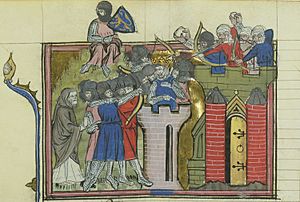
The crusaders reached Jerusalem in June 1099. They captured the city on July 15. On July 22, a meeting was held to choose a ruler for the new Kingdom of Jerusalem. Godfrey of Bouillon was chosen as the first leader. He didn't take the title of "king," but rather "Defender of the Holy Sepulchre."
The new kingdom became secure when the Fatimid Egyptian army was defeated at the Battle of Ascalon a month later. Godfrey began to set up the system of vassalage in the kingdom. He captured more cities like Jaffa, Haifa, and Tiberias.
Godfrey died in 1100. His brother, Baldwin of Boulogne, became the first "King of the Latins of Jerusalem." This set up the kingdom as a secular (non-religious) state. A Catholic church system was also created, but local Eastern Orthodox churches kept their own leaders.
Kingdom's Expansion
Under King Baldwin I, the kingdom grew even more. More Europeans came to live there. Baldwin helped to repopulate Jerusalem with Franks and local Christians. With help from Italian city-states and King Sigurd I of Norway, Baldwin captured important port cities like Acre (1104), Beirut (1110), and Sidon (1111). He also became the overlord of the other Crusader states to the north: Edessa, Antioch, and Tripoli.
Baldwin successfully defended the kingdom from Muslim attacks from Egypt, Damascus, and Mosul. Historians like Thomas F. Madden call Baldwin "the true founder of the kingdom of Jerusalem." He built a strong monarchy, conquered the coast, and set up strong borders.
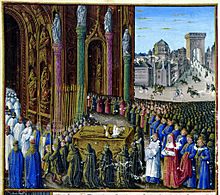
Baldwin died in 1118 without children. The crown passed to his relative, Baldwin of Le Bourg. Baldwin II was also a strong ruler. He defended against Fatimid and Seljuk invasions. Even though he was captured for a while, he led the crusaders to victory at the Battle of Azaz in 1125.
During his rule, the first military orders, the Knights Hospitaller and the Knights Templar, were created. The first written laws of the kingdom were also made. A trade agreement with Venice in 1124 led to the capture of Tyre. Baldwin II had four daughters. His eldest, Melisende, became his heir and queen after his death in 1131. She ruled with her husband, Fulk V of Anjou.
Edessa, Damascus, and the Second Crusade
Fulk was an experienced crusader. He brought military support to the kingdom. Not everyone liked having a foreign king. In 1132, Antioch, Tripoli, and Edessa tried to become fully independent from Jerusalem. Fulk defeated Tripoli and arranged a marriage to help settle things in Antioch.
In Jerusalem, some nobles didn't like Fulk favoring his own people from Anjou. This led to a revolt in 1134, which was settled by the church leader. After a scandal, Queen Melisende and her supporters gained more control of the government.
A new and dangerous enemy appeared: Zengi of Mosul, who had taken control of Aleppo. Zengi also wanted Damascus. If he united these three states, it would be a big threat to Jerusalem. In 1139, Damascus and Jerusalem formed an alliance to stop Zengi. Fulk used this time to build many castles, like Ibelin and Kerak.
After both Fulk and the Byzantine Emperor died in 1143, Zengi invaded and captured Edessa in 1144. This shocked Europe, and a Second Crusade arrived in 1148. The crusader kings, Louis VII of France and Conrad III of Germany, decided to attack Damascus. This was a complete failure. The French and German armies went home, and Damascus soon fell under the control of Nur ad-Din, Zengi's son.
Internal Conflicts and Byzantine Alliance
The failure of the Second Crusade had bad effects. Europeans were less willing to send large armies. Meanwhile, the Muslim states in Syria were united by Nur ad-Din. He saw the Kingdom of Jerusalem as a barrier to Muslim unity.
In Jerusalem, Queen Melisende and her son Baldwin III had a conflict. Melisende continued to rule even after Baldwin was old enough. In 1153, Baldwin crowned himself sole ruler. They eventually divided the kingdom, but Baldwin later took over his mother's lands. Melisende retired but remained an important advisor.
In 1153, Baldwin captured Ascalon, a fortress that had been used by Egyptian armies to attack Jerusalem. This made the southern border of the kingdom safer.
To strengthen the kingdom against the growing Muslim power, Baldwin III made an alliance with the Byzantine Empire. He married Theodora Comnena, a niece of Emperor Manuel I Comnenus. This alliance was meant to bring more help and wealth to Jerusalem.
When Baldwin died in 1162, his brother Amalric became king. He continued the alliance with the Byzantines. Amalric invaded Egypt several times because the Egyptians stopped paying tribute. This led to a complex series of battles and alliances involving the Egyptian vizier Shawar, Nur ad-Din's general Shirkuh, and later Shirkuh's nephew, Saladin.
In the end, Saladin became the Sultan of Egypt. He soon began to take control of Nur ad-Din's Syrian lands after Nur ad-Din died in 1174. When the pro-Western Emperor Manuel died in 1180, the Kingdom of Jerusalem lost its most powerful ally.
Struggle for Power and Saladin's Rise
After Amalric's death, his son Baldwin IV became king. He suffered from leprosy, a serious illness. Because of his illness, there was a struggle for power among the nobles. Some wanted war with Saladin, while others preferred peace.
Raymond III of Tripoli, Baldwin's cousin, became regent (a temporary ruler). Baldwin reached adulthood in 1176, but his illness meant he couldn't rule for long. His sister Sibylla was next in line. It was important for her to marry a European nobleman to get support from Europe. She married William of Montferrat, a cousin of the French and Holy Roman Emperors. William died soon after, leaving Sibylla pregnant with Baldwin V.
Another important figure was Raynald of Châtillon. He led raids into Muslim territory, even though the kingdom had a truce with Saladin. These actions made Saladin angry.
In 1177, Saladin invaded the kingdom. King Baldwin IV, despite his illness, led the army and defeated Saladin at the Battle of Montgisard. This was a great victory.
In 1180, Sibylla married Guy of Lusignan, a newcomer from France. This marriage was arranged to strengthen ties with Henry II of England, who was a cousin of Sibylla.
King Baldwin's leprosy worsened. In 1183, Guy of Lusignan was chosen as regent. However, Guy was criticized for not attacking Saladin when he had the chance. Baldwin, though very ill, took back control and appointed Raymond of Tripoli as military commander. Baldwin V, Sibylla's young son, was crowned as co-king.
Baldwin IV died in May 1185. His nephew, Baldwin V, became king, with Raymond of Tripoli as regent. However, Baldwin V was a sickly child and died in 1186.
Sibylla then claimed the throne. She was crowned queen and immediately crowned her husband, Guy of Lusignan, as king. Raymond of Tripoli and some other nobles did not agree with this.
Loss of Jerusalem and the Third Crusade
Raymond of Tripoli allied with Saladin against Guy. Saladin was eager to attack the Crusader kingdom. Raynald of Châtillon attacked Muslim caravans, which angered Saladin even more. Guy and Raymond finally made peace, but they disagreed on how to fight Saladin.
On July 4, 1187, the army of the Kingdom of Jerusalem was completely destroyed at the Battle of Hattin. Many leaders were killed or captured, including Raynald (executed by Saladin) and King Guy (imprisoned).
Over the next few months, Saladin easily conquered almost the entire kingdom. Only the port city of Tyre remained in Crusader hands, defended by Conrad of Montferrat. The fall of Jerusalem in 1187 effectively ended the first Kingdom of Jerusalem. Many people were allowed to leave, but some were sold into slavery.
The capture of Jerusalem led to the Third Crusade, which began in 1189. It was led by powerful European kings like Richard the Lionheart and Philip Augustus.
King Guy of Lusignan, after being released, began to besiege Acre in 1189. During the long siege, Queen Sibylla died. Guy no longer had a legal claim to the throne. The crown passed to Sibylla's half-sister, Isabella. Isabella married Conrad of Montferrat, who was then elected king.
When Richard the Lionheart arrived in 1191, he supported Guy, while Philip supported Conrad. After Acre fell, Philip went home. Richard defeated Saladin at the Battle of Arsuf (1191) and the Battle of Jaffa (1192), taking back most of the coast. However, he could not recapture Jerusalem.
Conrad was murdered in April 1192. Isabella then married Henry II of Champagne, Richard's nephew. Richard sold the island of Cyprus to Guy of Lusignan as compensation.
The crusade ended peacefully with the Treaty of Ramla in 1192. Saladin allowed Christians to visit Jerusalem. The Crusader nobles then began to rebuild their kingdom from Acre and other coastal cities.
The Kingdom of Acre
For the next 100 years, the Kingdom of Jerusalem was a small state along the Syrian coast. Its capital was moved to Acre. It controlled most of the coast of modern-day Israel and southern Lebanon. It also had some other cities like Ascalon and a few fortresses. It also had influence over Tripoli and Antioch.
The new king, Henry of Champagne, died in 1197. Isabella married for a fourth time to Aimery of Lusignan, Guy's brother. Aimery was already King of Cyprus. A new crusade in 1197 recaptured Beirut and Sidon for the kingdom. A five-year truce was made with the Ayyubids in 1198.
The Ayyubid empire had fallen into civil war after Saladin's death in 1193. This division among the Muslims sometimes helped the Crusaders.
A Fourth Crusade was planned to retake Jerusalem through Egypt, but it ended up attacking Constantinople in 1204. Most crusaders never reached the Holy Land. Both Isabella and Aimery died in 1205. Isabella and Conrad's daughter, Maria of Montferrat, became queen. Her half-brother John of Ibelin, the Old Lord of Beirut ruled as regent until Maria married John of Brienne in 1210. Maria died in childbirth in 1212, and John of Brienne continued to rule for their daughter, Isabella II.
Fifth and Sixth Crusades and Frederick II
In 1215, a new crusade was called against Egypt. In 1218, the Fifth Crusade began. Crusader fleets sailed to Egypt and besieged Damietta at the mouth of the Nile. The siege was long, but Damietta was captured in November 1219. The Egyptian sultan al-Kamil offered a truce and to give Jerusalem back, but the crusaders refused. They waited for Frederick II to arrive.
In 1221, the crusaders marched towards Cairo but were stopped by the flooding Nile. The sultan defeated them and took back Damietta. Frederick II never arrived.
After this failure, John of Brienne traveled to Europe for help. He found support from Frederick II, who married John's daughter Isabella II in 1225. Isabella died giving birth to their son Conrad IV in 1226. Conrad inherited the throne of Jerusalem, but he never came to the East.
Frederick II finally arrived on the Sixth Crusade in September 1228. He claimed to rule the kingdom for his infant son. Frederick immediately had problems with the local nobles. He also came into conflict with John of Ibelin, a powerful noble.
Frederick made a deal with Sultan al-Kamil. In February 1229, Jerusalem, Bethlehem, and Nazareth were returned to Christian control without a fight. This was in exchange for a ten-year truce. However, the church leader in Jerusalem, Gerald of Lausanne, was unhappy and placed the city under a ban. Frederick crowned himself in Jerusalem, but because of the ban, the city was never fully part of the kingdom again. The kingdom continued to be ruled from Acre. Frederick had to return home in 1229.
Internal Conflicts and the Barons' Crusade
Frederick sent an army in 1231, but they couldn't take control of Acre. John of Ibelin's supporters formed a local government in Acre and recaptured Beirut.
Meanwhile, the treaty with the Ayyubids was ending in 1239. A new crusade, called the Barons' Crusade, arrived in Acre. It was led by Theobald IV of Navarre. The crusaders decided to rebuild Ascalon and attack Damascus.
The Ayyubid rulers were fighting among themselves. The crusaders were defeated by the Egyptian army at Gaza in November 1239. Jerusalem was recaptured by the Muslims in December.
However, Theobald made a new treaty with a Muslim ruler from Damascus. This treaty gave Jerusalem back to Christian control, along with even more territory than Frederick had gained. Theobald returned home in 1240. Richard of Cornwall arrived and completed the rebuilding of Ascalon. He also made peace with the Egyptian ruler.
Even though the kingdom was mostly restored, the nobles continued to fight among themselves. The Templars and Hospitallers, two military orders, even attacked each other.
Louis IX's Crusade and the Mamluks
The Ayyubids were still divided. One ruler, Ayyub in Egypt, hired the Khwarazmians to fight for him. These were nomadic Turks. In 1244, the Khwarazmians sacked Jerusalem, leaving it in ruins. In October, the Khwarazmians and the Egyptian army defeated the Frankish army. By 1247, Ayyub had taken back most of the land given to the crusaders.
A new crusade was planned, led by Louis IX of France. Louis arrived in Cyprus in 1248 and gathered an army. The target was Egypt. Damietta was captured in June 1249. However, the crusaders were defeated at the Battle of al-Mansurah in February. Louis was taken captive. He was later released in May in exchange for Damietta and a large ransom.
For the next four years, Louis stayed in Acre. He helped rebuild Acre, Caesarea, Jaffa, and Sidon. He also made truces with the Ayyubids in Syria. He sent messages to the Mongols, who were becoming a threat to the Muslim world. Louis returned home in 1254.
During these events, the regency of Jerusalem passed to Hugh II, the infant King of Cyprus. His mother, Plaisance of Antioch, ruled for him.
Mongol Invasions
Around this time, the Mongols arrived in the Near East. They had already caused the Khwarazmians to move. They attacked and destroyed Baghdad in 1258, and Aleppo and Damascus in 1260. This ended the Abbasid caliphate and the last parts of the Ayyubid dynasty.
Some Mongols were Christians, but the nobles of Acre refused to surrender to them. The Mongols didn't pay much attention to the small kingdom. However, there were some fights. The Mongol conquest was stopped when their commander, Hulagu, went home. The Mamluks of Egypt then defeated the Mongols at the Battle of Ain Jalut in September 1260. All of Syria came under Mamluk control. The Mamluk sultan Qutuz was then killed by Baibars, who was not friendly to the Franks.
Fall of Acre
The Kingdom of Jerusalem continued to have internal problems. The Mamluks, led by Baibars, took advantage of these disputes. They began to conquer the remaining Crusader cities along the coast. In 1265, Baibars took Caesarea, Haifa, and Arsuf. In 1268, he captured Jaffa and Beaufort, and then besieged and destroyed Antioch.
Hugh III, who had become King of Jerusalem in 1269, made a truce with Baibars. Baibars thought Louis IX was planning another crusade to Egypt, but Louis went to Tunis instead and died there. Baibars was free to continue his attacks. In 1271, he captured the Hospitaller and Teutonic Knights' castles of Krak des Chevaliers and Montfort Castle.
Prince Edward of England arrived, but he could only arrange a ten-year truce with Baibars. Edward left in 1272. No other large crusades arrived. Hugh III's power on the mainland weakened. He left for Cyprus, leaving a deputy in Acre.
In 1277, Charles of Anjou bought a claim to the throne of Jerusalem. The Venetians and Templars supported him. Baibars died in 1277 and was replaced by Qalawun. The truce expired in 1281 and was renewed.
Hugh III died in 1284. His son Henry II became king in 1285. That year, Qalawun captured the Hospitaller fortress of Marqab. The Venetians and Genoese started fighting again in 1287. Tripoli fell to Qalawun in 1289.
The end of the Crusader kingdom was near. In 1290, newly arrived crusaders rioted in Acre and attacked Muslim merchants. Qalawun died, but his son al-Ashraf Khalil arrived to besiege Acre in April 1291. Acre was defended by many groups, but they were greatly outnumbered. The city fell on May 18. Many defenders died, but some leaders escaped.
Tyre fell the next day without a fight. Sidon fell in June, and Beirut in July. The crusaders moved their headquarters to Cyprus. Some attempts were made to retake land, but with the loss of the island of Arwad in 1302–1303, the Kingdom of Jerusalem no longer existed on the mainland.
For many centuries, the kings of Cyprus and other European monarchs continued to use the title "King of Jerusalem."
Life in the Early Kingdom
The number of European (Latin) people in the kingdom was always small. Many of the first crusaders went home. From the beginning, the Latins were a small ruling group over the native Jewish, Samaritan, Muslim, Greek Orthodox, and Syriac populations, who were much more numerous.
As new generations grew up in the kingdom, they started to see themselves as natives. They still felt like Western Europeans, but their clothing, food, and trade were influenced by Eastern customs. As one writer, Fulcher of Chartres, said around 1124: "For we who were Westerners now have been made Easterners. He who was a Roman or Frank has in this land been made into a Galilean, or an inhabitant of Palestine. We have already forgotten where we were born."
Crusaders and their descendants often learned to speak Greek, Arabic, and other Eastern languages. They sometimes married native Christians. However, the Crusader states remained a distinct European colony in the heart of the Muslim world.
Many travelers visited the new kingdom and wrote about it. These accounts, along with the writings of William of Tyre, an important church leader, give us much of our information. Muslim writers like Usamah ibn Munqidh also wrote about Crusader society.
Crusader Society
At first, the kingdom had few loyal subjects and knights. But with Italian traders, military orders, and European immigrants, the kingdom grew. A feudal society developed, similar to Europe but with its own differences.
Historians have debated how much the crusaders mixed with the native people. Some believed they lived in a fully integrated society. Others argued that crusaders lived completely separate from the native people, who were seen as a constant threat.
A more recent view suggests that the different groups (Latin Christians, Greek and Syriac Christians, Shia and Sunni Arabs, Jews, Samaritans) all had differences among themselves. Relations between Eastern Christians and Latin crusaders were complex, not always friendly or hostile. Eastern Christians likely felt closer to their fellow Christians than to Muslim Arabs.
Crusaders settled in both cities and rural areas, especially where Eastern Christians lived. Areas that were mostly Muslim had very few Crusader settlements.
The crusaders adapted existing systems and brought their own customs from Europe. Nobles had vassals, just like in Europe. Farming was organized using a Muslim system of land ownership, which the crusaders didn't change much.
It's hard to find much information about Muslims in the Latin chronicles. The crusaders often didn't write about them. Muslims, Jews, and Eastern Christians had few rights in the countryside. They were essentially owned by the Crusader lord who owned the land. However, they kept their own laws and courts. Muslims joined them at the lowest level of society. The leader of a Muslim or Syriac community had a lot of freedom because the Crusader lords often didn't live on their lands.
An Arab traveler, Ibn Jubayr, wrote about Muslims living under Christian rule in the late 1100s. He said they lived well and praised the Franks' justice, even though they had to pay taxes.
In the cities, Muslims and Eastern Christians were free, but Muslims were not allowed to live in Jerusalem itself. They were second-class citizens and had no role in politics or law. Citizens of Italian city-states also had a lot of freedom in their own areas in the port cities.
Interactions between Franks and native Muslims and Christians often showed a practical way of living together. There was some exchange between the upper classes. Contact happened for things like taxes or translation. Frankish Christians sometimes had non-Frankish priests, doctors, and other workers in their homes. Some Franks even adopted better hygiene practices from the Arabs.
Population
It's hard to know the exact population of the kingdom. Some scholars estimate there were about 120,000 Franks and 100,000 Muslims in the cities, with another 250,000 Muslim and Eastern Christian peasants in the countryside. This means crusaders made up about 15–25% of the total population. Other estimates suggest between 300,000 and 360,000 non-Franks, with Muslims being the majority in many parts of the kingdom. However, there isn't enough clear evidence to be certain.
The Mamluks, led by Baibars, eventually removed the Franks from the Middle East. When Antioch fell (1268), Tripoli fell (1289), and Acre fell (1291), Christians who couldn't leave were killed or enslaved. This ended Christian rule in the Levant.
Slavery
Some Muslim slaves lived in the Kingdom. There was a large slave market in Acre. Italian merchants sometimes sold Christians from Eastern Europe as slaves alongside Muslim slaves. However, paying a ransom for prisoners of war was more common than slavery. Many prisoners were taken each year, and ransom money flowed between Christian and Muslim states.
It was probably not hard for prisoners and slaves to escape, as most people in the countryside were Muslim. The only legal way for a slave to become free was to convert to Catholic Christianity. No Christian, whether Western or Eastern, was allowed to be sold into slavery.
The laws of the kingdom, called the Assizes of Jerusalem, allowed for the trade of "villeins" (rural workers similar to serfs), animals, or other goods. People could become slaves by birth, by being captured in a raid, or as punishment for debt or helping a runaway slave.
The nomadic Bedouin tribes were considered the king's property and were protected by him. They could be sold or given away like other property. Later, they were often protected by a lesser noble or a military order.
Economy
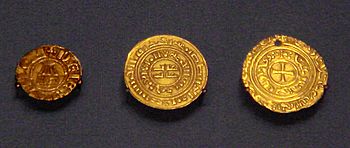
The cities and the presence of Italian merchants led to a strong commercial economy, more than an agricultural one. Palestine had always been a center for trade. Now, this trade extended to Europe. European goods, like wool textiles, went to the Middle East and Asia. Asian goods were brought back to Europe.
Jerusalem was especially involved in the silk, cotton, and spice trade. Other items that came to Europe through trade with Crusader Jerusalem included oranges and sugar. The Italian city-states made huge profits from this trade, which helped lead to the Renaissance later on.
Italian colonies in Palestine also grew sugar for export to Europe. Sugar cane had been brought to Palestine by the Arabs. To work the sugar fields, Italian settlers used slaves or serfs of Arab or Syrian origin. Sugar production grew in the 1200s. This sugar system in the Kingdom of Jerusalem is seen as an early example of the sugar plantations in the Americas.
Jerusalem also made money from tribute payments. These came from coastal cities not yet captured, and later from neighboring states like Damascus and Egypt. After Baldwin I expanded his rule, Jerusalem also taxed Muslim caravans traveling between Syria, Egypt, and Arabia. The kingdom's money-based economy meant they could pay for mercenaries, which was unusual in medieval Europe. These mercenaries could be other European crusaders or Muslim soldiers.
Education
Jerusalem was the main center for education. There was a school in the Church of the Holy Sepulchre where basic reading and writing in Latin were taught. Wealthy merchant children could go there, along with children of nobles. It's thought that William of Tyre, a famous historian, was a classmate of future king Baldwin III.
Higher education had to be done at universities in Europe. Warfare was more important than philosophy or theology in Crusader Jerusalem, so a university didn't develop there. However, the nobles and many Franks were well-educated. Lawyers and clerks were common. The royal family and nobles enjoyed studying law, history, and other subjects.
Jerusalem had a large library with Latin and Arabic books. The Church of the Holy Sepulchre had a place where books were copied. The city also had an office where royal documents were made. Besides Latin, people spoke French, Italian, Greek, Armenian, and even Arabic.
Art and Architecture
In Jerusalem, the biggest building project was expanding the Church of the Holy Sepulchre in the Western Gothic style. This project brought all the separate shrines on the site into one building and was finished by 1149.
Outside Jerusalem, castles and fortresses were the main focus of building. Kerak and Montreal in Oultrejordain, and Ibelin near Jaffa are examples of Crusader castles.
Crusader art was a mix of Western, Byzantine, and Islamic styles. The major cities had baths, indoor plumbing, and other advanced hygiene tools that were rare elsewhere. Famous examples of Crusader art include the Melisende Psalter, a decorated book from 1135 to 1143, and the sculpted Nazareth Capitals. Paintings and mosaics were popular, but many were destroyed by the Mamluks.
Government and Legal System
After the First Crusade, land was given to loyal supporters of Godfrey, creating many feudal lordships. The king was helped by several state officers. The king and court were usually in Jerusalem, but also often in Acre, Nablus, or Tyre. In Jerusalem, the royal family lived near the Tower of David.
Because nobles often lived in Jerusalem, they had more influence on the king than in Europe. The nobles and bishops formed the Haute Cour (high court). This court confirmed new kings, collected taxes, made coins, gave money to the king, and raised armies. The Haute Cour was the only court for nobles, handling serious crimes and feudal disputes. Punishments included losing land, exile, or death.
The first laws were likely set by Baldwin II in 1120. The most complete collection of laws, known as the Assizes of Jerusalem, was written in the mid-1200s.
There were other courts for non-nobles and non-Latins. The Cour des Bourgeois handled cases for non-noble Latins and disputes between non-Latins, who had fewer legal rights. Special courts existed in coastal cities for trade and sea matters. The extent to which native Islamic and Eastern Christian courts continued is not fully known, but local leaders likely had some legal power. The Cour des Syriens judged non-criminal matters for native Christians.
Italian communities had almost complete freedom from the early days of the kingdom because of their military and naval support. This included the right to run their own justice system.
The king was the head of the Haute Cour, but legally he was just the "first among equals."
Legacy of the Kingdom
After losing all their land in the Levant in 1291, there were later attempts at new crusades to recapture Jerusalem. However, with the rise of the Ottoman Empire, these became more about defending Europe.
Henry IV of England visited Jerusalem in 1393–4 and later promised to lead a crusade to retake the city, but he died before he could. The Levant remained under Ottoman control from 1517 until 1918.
With the Fall of Ruad in 1302, the Kingdom of Jerusalem lost its last outpost on the coast. Its closest possession to the Holy Land was now Cyprus. Henry II of Jerusalem kept the title of king of Jerusalem until his death in 1324. The kings of Cyprus continued to claim this title.
The title "King of Jerusalem" was also used by the Angevin kings of Naples. They bought a claim to the throne in 1277. This claim became part of the crown of Naples. The Popes often supported this title.
Later, control of Naples passed to the House of Aragon in 1441. So, the title was claimed by the kings of Spain. After the War of the Spanish Succession, both the House of Bourbon and the House of Habsburg claimed it.
Today, the title is still used by the Spanish Crown, currently held by Felipe VI of Spain. It was also claimed by Otto von Habsburg until 1958, and by the kings of Italy until 1946.
Images for kids
See also
 In Spanish: Reino de Jerusalén para niños
In Spanish: Reino de Jerusalén para niños




